How to Wire 2 Dual 2 Ohm Subs to 1 Ohm
One of the things people have the most trouble with is wiring multiple subs or dual voice coil subs to an amp. This post will explain what series and parallel wiring is, a little bit on Ohm's law, the difference between single and dual voice coil subs, and how to wire subs to different Ohm loads with subwoofer wiring diagrams.
If you just want to get to wiring and don't care about the technical stuff, click here to be brought to the subwoofer wiring diagrams page.
How to Wire Subs: Series and Parallel Wiring
Series
Series wiring for speakers means you are connecting the speakers like a chain. The positive terminal from one speaker connects to the negative terminal of the next speaker, then the positive of that speaker connects to the negative of the next speaker. You can do this with an infinite number of speakers. In this arrangement, if one part of the circuit is removed, nothing will work.
Series wiring will add the impedance of each speaker together, so for example: if you had three 2 Ohm speakers wired in series, the total impedance would be 6 Ohms. This will be explained in greater detail when I get to Ohm's law.
For series wiring: Total Impedance = Sub Impedance x Total # of Subs
Parallel
Parallel wiring connects all of the positive terminals together and all of the negative terminals together. This means if part of the circuit goes out, all of the rest will still be connected, but the impedance will be affected.
Parallel wiring of speakers reduces the resistance seen by the amp, therefore making the amp work harder by pulling more current. Instead of adding all of the impedances together, the total impedance will be reduced further and further with each speaker added to the circuit. For example: if you wire (2) 4 Ohm subs together in parallel, you will get a total load of 2 Ohms.
For parallel wiring: Total Impedance = Sub Impedance / Total # of Subs, so if you have (4) 2 Ω SVC subs all wired in parallel, the total impedance will be 2 Ω / 4 subs = 0.5 Ω
Ohm's Law
Ohm's law is the governing equation for all electrical circuits, and the equation is V = I x R where V=voltage, I=current, and R=resistance.
Voltage is constant for car audio (12V nominal, 14.4V with a running vehicle).
Resistance is constant (the total impedance your speakers are wired to).
Current will change depending on your impedance and the power your amp is capable of.
Rearrange the equation to read I = V / R.
This shows that if resistance is decreased, then the current the amp is pulling will increase. Therefore, the power output of the amplifier will increase because of the power equation P = V x I. Now you see why wiring subs to lower impedances will get more power out of your amp, and as a result and is why a lot of amps don't like seeing too low of an Ohm load. A low ohm load will try to overpower the amp by pulling too much current.
This is a great Ohm's Law chart to quickly see all the equations for power, current, voltage, and resistance:
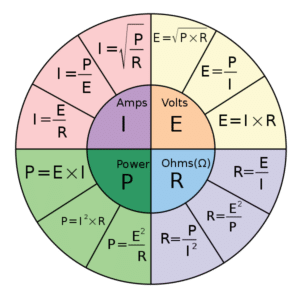
Single vs. Dual Voice Coil
The number of voice coils a subwoofer has determines your wiring options. Many people think DVC subs are more powerful than SVC or vice versa, but this is not the case. They make so many different versions of the same subs so you can get the total Ohm load you need no matter how many subs you plan on connecting together. A single DVC sub has two different wiring options right out of the box, whereas a SVC sub only has one.
Single Voice Coil (SVC)
Single voice coil subs are subwoofers that only have one voice coil. The impedance of a SVC sub will only be what that sub is rated at. For example, a single SVC 2 Ohm sub can only be wired to 2 Ohms.
Dual Voice Coil (DVC)
Dual voice coil subs have two voice coils. A single DVC sub can be wired to two different Ohm loads right out of the box by wiring it in either series or parallel. For example: a single 4 Ohm DVC sub can be wired to either 2 Ohms (parallel) or 8 Ohms (series). The Ohm rating on DVC subs is actually the rating per voice coil, so you cannot wire a 4 Ohm DVC sub to 4 Ohms.
How to Wire Subs to Desired Impedance
Now that you know what series wiring will raise total impedance and parallel will drop total impedance, I will show you how this is used in subwoofer wiring. Whenever you have (2) SVC subs of the same impedance, series wiring will always double that number, and parallel wiring will always half that number. Some math is needed for all other cases, especially when wiring multiple DVC subs together since you can have a mixture of series and parallel wiring in the same circuit.
For example: this circuit of two DVC 2 Ohm subs wired to a total load of 2 Ohms at the amp has the voice coils of each sub wired in series, but the two subs are then wired to each other in parallel. Wiring a DVC 2 Ohm sub in series gives you 4 Ohms. Then wiring two 4 Ohm subs in parallel will give you 2 Ohms. Hopefully that makes since.
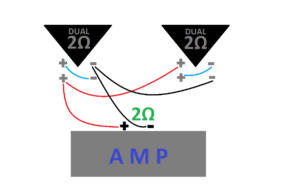
Double check your final impedance with a multimeter after wiring before connecting your subs to the amp. I personally use this one from Amazon and it has worked great for me.

Below are some more diagrams for the most common wiring configurations. Post a comment or send an email if you don't see the configuration you plan on wiring, and I can help you out. Here is a link to just the wiring diagrams for easier access: http://caraudioadvice.com/subwoofer-wiring-diagrams/
Subwoofer Wiring Diagrams – How to Wire Subs:
Single Voice Coil
Two 2 Ω subs wired in series to 4 Ω
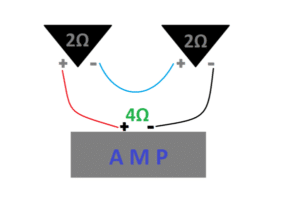
Two 4 Ω subs wired in series to 8 Ω
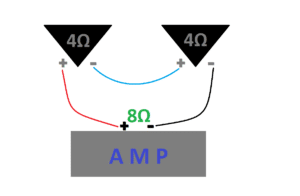
Two 2 Ω subs wired in parallel to 1 Ω
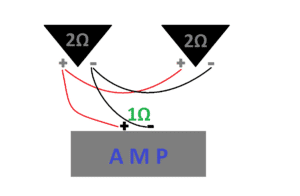
Two 4 Ω subs wired in parallel to 2 Ω
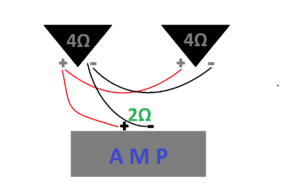
Dual Voice Coil
One DVC 2 Ω sub wired in series to 4 Ω
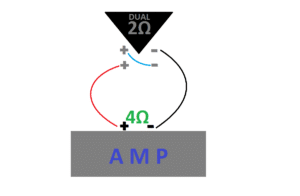
One DVC 4 Ω sub wired in series to 8 Ω
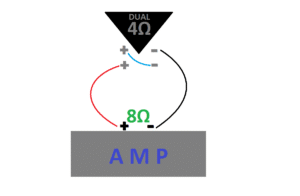
Two DVC 2 Ω subs wired to 0.5 Ω
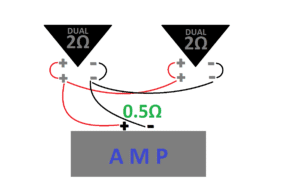
Two DVC 4 Ω subs wired to 1 Ω
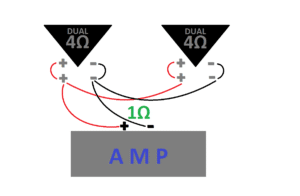
One DVC 2 Ω sub wired in parallel to 1 Ω
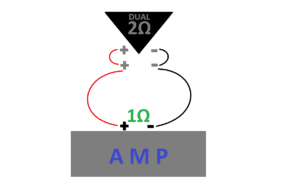
One DVC 4 Ω sub wired in parallel to 2 Ω
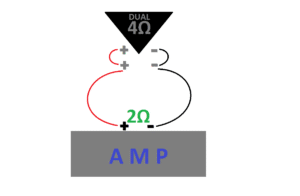
Two DVC 2 Ω subs wired to 2 Ω

Two DVC 4 Ω subs wired to 4 Ω
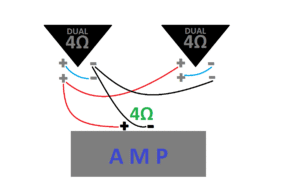
How to Wire 2 Dual 2 Ohm Subs to 1 Ohm
Source: https://caraudioadvice.com/how-to-wire-subs-seriesparallel-ohms-and-single-vs-dual-voice-coils/